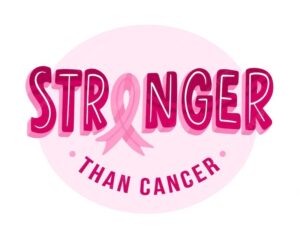Strength Training for Cancer
It’s October, which means fall colors are in their full array. Everywhere you go the landscape is layered with orange pumpkins, brown corn stalks, and red and yellow leaves. But another color pops up more than usual this time of year on shirts, headbands, and even football fields. The non-fall color that we seem to see everywhere in October—pink.
In 1985 the American Cancer Society initiated its first week-long breast cancer awareness campaign. In 1992, the week extended into a month-long event with the goal of educating women about breast cancer and the importance of mammograms. In that same year, Estee Lauder cosmetics handed out 1.5 million pink ribbons as a visual reminder of breast cancer awareness month. The NFL has become the largest supporter of breast cancer awareness month. Pink is everywhere in the month of October to raise awareness to the most diagnosed cancer among American women.
About 1 in 8 women in America will receive a breast cancer diagnosis. While that’s pretty high, it’s actually not the most common cancer in women; skin cancer claims that title, with a prevalence of 1 in 3 women. Other highly diagnosed cancers in women include colorectal, endometrial, lung, cervical, and ovarian.

When we talk about cancers that affect women, we should remember that more than just breast cancer should concern us. We also need to understand that cancer is increasing at an alarming rate in younger age groups. A new study shows that cancer rates for Americans in their 30s increased 19.4% in the past 10 years. Women represented the biggest increase in this age group, experiencing an 8% increase in breast cancer and a 15% increase in colon cancer.
We also need to understand that prevention goes far beyond screening. Living a healthy lifestyle throughout all your life is critical to cancer prevention. We recently talked about the role of antioxidants in cancer prevention. And a few months ago, we discussed the role of fasting and autophagy in eliminating cancer cells. But what about strength training? What role does your 20 Minutes A Week play in cancer prevention, care, and therapy?
Strength Training’s Role in Cancer Prevention
A study published in Medicine & Science in Sports & Exercise in 2019 examined strength training in regard to risk of 10 common types of cancer. The study found a significantly lower risk of colon cancer in individuals who lift weights and a slightly reduced risk of kidney cancer. This study is extremely important because colon cancer is on the rise in younger women. The reduced risk of colon cancer from strength training may be because exercising at higher levels of intensity can improve gut microbiome.
A study published in 2022 found that resistance training reduced risk of cancer mortality by 14%. This overall decrease may be due to the fact that strength training stimulates greater development of lean muscle mass, which helps regulate blood glucose, and could in turn lead to a lower risk of cancer.
Strength Training’s Role in Fighting Cancer
A common side effect of cancer is unexplained weight loss. This often happens due to loss of appetite, fatigue, nausea, or increased metabolism from the cancer itself. This cancer-associated weight loss, referred to by doctors as “cachexia,” results in a greater loss of muscle than fat. About 50% of all cancer patients suffer from cachexia.
Doctors and researchers have noticed that as cancer patients lose muscle mass, T-cell function decreases. T-cells are a type of white blood cell that fight infections and protect you from diseases. We’ve never really understood why the loss of muscle mass affects T-cells, so a group of scientists at the German Cancer Research Center infected mice with a virus and analyzed the gene expression in their skeletal muscles. What they found was absolutely amazing.
It turns out that during chronic infections, muscle cells release an increased amount of a messenger substance called interleukin-15. Interleukin-15 is a type of white blood cell, specifically a cytokine, that signals natural killer cells to attack a virus.

The research scientists found that interleukin-15 also caused the body to store T-cell precursors in muscle cells. This process kept a reservoir of T-cell precursors in muscle cells protected from contact with chronic inflammation.
So, if the T-cells, which are actively fighting the infection, lose their functioning through continuous stimulation, the precursor cells can migrate from the muscles and develop into functional T-cells. This enables the immune system to fight a virus or cancer cells continuously over a long period of time.
Let me say this a little more simply. Muscle cells in mice actually stored a reservoir of cancer- and virus-fighting white blood cells. When the active white blood cells became fatigued, the muscle cells released fresh white blood cells like a tag team wrestler, well rested and ready for a smack down.
In the study, mice with more muscle mass mitigated chronic viral infections better than those with weaker muscles.
Strength Training’s Role in Recovering from Cancer
As I mentioned above, one of the problems with cancer and cancer treatment is cachexia, the accelerated loss of muscle mass. A common challenge among female breast cancer survivors is adapting to life with less upper body strength once they’ve beaten cancer. A study published this month looked at the effects of strength training and aerobic training on quality of life in breast cancer survivors. The women in the study produced “a large increase in upper-, lower-, and full-body muscular strength.
Strength training is important for anyone at any stage of life. But these studies show it could be critical for surviving and recovering from cancer of any kind. Having strong muscles will keep you moving, and they will also keep your immune system functioning, especially during cancer treatments.
A few years ago, one of our long-standing clients, Joan O’Connor, developed stage IV breast cancer. Joan believed it was important to continue her strength training program at Exercise Inc to keep her strong through her chemotherapy treatments. Joan’s determination during her cancer battle inspired us all. Check out her story here.
Stay Strong,
Bo Railey

